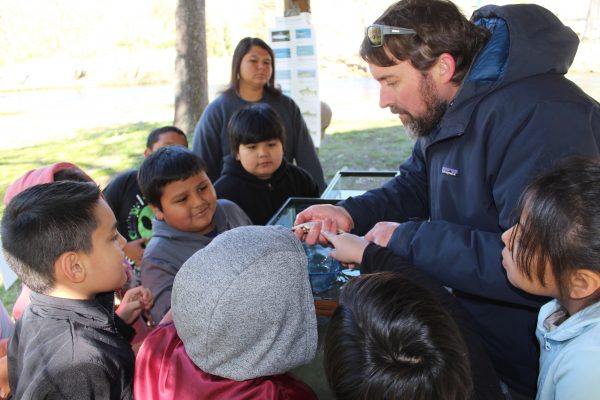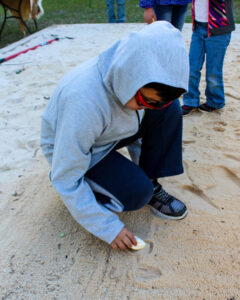
AQUATIC: Cherokee Elementary School second graders look on in amazement as Michael J. LaVoie, EBCI Natural Resources Program manager, shows them a green fin darter fish, one of several aquatic species he shared with them during a program on the Oconaluftee Island Park on the morning of Friday, April 20. (SCOTT MCKIE B.P./One Feather photos)
By SCOTT MCKIE B.P.
ONE FEATHER STAFF
Two days prior to Earth Day, the EBCI Natural Resources Program hosted second grade students from Cherokee Central Schools in a program to teach them about Cherokee’s natural resources and environment. The program, in its second year, was held on the Oconaluftee Island Park on the chilly morning of Friday, April 20. Program staff set up stations where students got hands-on education on a variety of topics ranging from area plants and animals to conservation efforts.
“This is a program that gets our youth out into the natural environment where we can demonstrate the kinds of practices, methods, and activities that we conduct as professionals,” said Joey Owle, EBCI Secretary of Agriculture and Natural Resources. “I think this is an essential program and an essential service that we need to provide for our community because we can engage them at a young age and they learn the importance of it, and we hope that it carries on through their adult life. It’s exciting to have them out here. They’re active right now, asking questions and are engaged, and this is exactly what we want to see with our kids for the future. They need to have an understanding of what we find important and value for our environment and our culture.”
Michael J. LaVoie, EBCI Natural Resources Program manager, commented, “We’re really happy to get kids outside for them to learn about the different facets of what the Natural Resources Program wants to manage for today and for future generations. We have a variety of different stations where they are learning about fish and trees, mammals, and amphibians. We’re trying to get the students interested in our local environment and appreciate all that we have here. We live in such a rich and diverse part of the world that it’s easy for kids to overlook how important and special this place is when they aren’t able to see a lot of the things that are here for our community.”
Set up under a banner that read “Tsesdi tsaditahv ama duwega gasohi ulosv yigesvna” which translates from Cherokee language into English as “Don’t drink from the river unless water is running over a salamander’s back”, Caleb Hickman, Ph.D., EBCI Natural Resources supervisory fisheries and wildlife biologist, was teaching the students about various types of local salamanders.
“We’ve been trying to name these salamanders in Cherokee,” he told the students, “because we can better describe them in Cherokee language than we can in Latin.”
The students were eager to learn, and a few of them shared their experiences with the One Feather.
“I learned that opossums will sometimes build their homes in the trees,” said Zoe De Los Reyes.
Her classmate, Maia Lane, commented, “I learned that salamanders will curl up when they are scared.”
John Calvin Gloyne said, “I learned that bats aren’t birds. They’re actually mammals because they have fur and teeth, but they do fly.”






